Abstract
Physical training is one of the most important factors in football game. The present and future competitions require a special training in every respect, among which physical training and psycholgical factor (own will) become „sine qua non” conditions. From the very beginning there was a necessity to link the motility qualities of the players to the psychological ones and thus they were called psycho-physical qualities. The main objective of general physical training, no matter the sport, is the improvement of effort capacity. The more the working potential, the easier the body adapts to the increasing requests for physical and psychological training. This article intends to present a training model for individualized physical training of football players that specialize in the junior “B” striker position. Guidance during the training session has a very important role. Physical training is a part of full training preparation to develop and improve the physical qualities who are necessary in the football game. To realize a better physical training, in modern football game, is made only if the multilateral physical training is combining with the general physical training to obtained superior results. If we talk about physical training in football, performance is strictly determined by the level of development of a complex set of motion qualities.
Keywords: Individualinstructionfootballphysical training
Introduction
Specific physical training is founded on general physical training. The main objective of specific physical training is to continue the physical development of the player according to his physiologic and methodic particularities. The physiologic specialization prevails in successful competitions. These potential adaptations of the player facilitate a large amount of effort during training sessions and, finally, during competitions. Moreover, a large physiologic capacity supports a quick recovery (Colibaba, 1998).
The specific physical training requires a large amount of training made possible only by decreasing its intensity. If the intensity increased, without a prior strengthening of player’s body, the central nervous system and the entire body would be overtaxed and the consequences would be exhaustion, tiredness and injuries (Bompa, 2002).
Discuss the importance of physical training for senior football players, the interdependence between the physical, technical and tactical qualities and the development of motility qualities. In chapter “Development of motility qualities”, the author presents the exercises used to develop motility qualities, (Bompa, 2002). Some publications, (Gârleanu 1999), discuss the motility skills development focusing on developing separate model lessons and show a wide range of means to develop each physical quality in turn. (Cojocaru, 2001)
Some authors, (Niculescu, & Ionescu, 1975), present us ways to improve technique and tactics of football game, applying some general methods and also specific methods to each factor of training. The combination of general and specific methods gives the work a special value by giving coaches multiple opportunities for training sessions, regardless of classification category. Very important is the awareness of the athlete, being the "most important expression of activation" (Stancu, 2015, p.82).
Literature reveals many aspects regarding the training of football players and coaches, (Neţa, 2005). The value of this work consists in how the author thinks about the physical, technical and tactical training, as well as about the way the principles of football game are applied. Moreover, the work deals with the interference of motility qualities. By knowing this, the coach can develop and improve the physical qualities of the players (Cernaianu, 2002)
The authors give different definitions to physical training:
“Physical training encompasses a whole system of measures that ensure a high functional capacity of the body by the high level of development of basic and specific motility qualities, best values of the morpho-functional indices, full mastery of the exercises used and a state of perfect health” (Niculescu, & Ionescu, 1975, p. 145-147). The same author states that it enriches the general fund of motility abilities and supports the harmonious development of morpho-functional indices conditioning the practice of every sport, (Motroc. 1996; Cojocaru, 2002).
“By physical training it is generally understood, the stage of training the athletes’ body. They say that an athlete reaches a good physical training when he gets a high level in terms of his physical abilities: speed, strength, skills, stamina, and his mental and intellectual skills - will, insight and spirit of combination, etc” (Neţa, 2008). “In football, general physical training has to provide the player with the morphologic, functional and motility development he needs in order to get the necessary qualities used during a game. Hence the importance of selecting the means for general physical training of the players. These means should contribute to the development of basic physical qualities, the improvement of motility abilities according to each game” (Neţa, 2008, p. 268).
Regarding the training of football players „we emphasize the necessity to know the energetic substrata and the mechanisms that supply energy for each form of motility capacity so that the training stimuli applied during physical training should influence the effort capacity of the body and develop the individual’s abilities” (Trapattoni & Cecchini, 2005, p. 112-113).
Problem Statement
“Physical training in football aims at increasing the functional capacity of the body, basic motility skills development and enrichment of the player motility base. These three main goals of physical training are constant throughout the training sessions, but they get different values for each stage of training: beginner, advanced and performance, as well as for each period and training stage” (Leali, 2006, p. 194-200);
“Physical training represents the whole system of means used to increase the functional capacity of the body by a high level of basic and specific motility qualities, the increase of morpho-functional indices based on a perfect health”. (Radulescu, 2007) “Physical training, basic component of sports training, is a complex activity designed to provide players a high potential, expressed in terms of superior morpho-functional indices, the development of motility qualities and motility skills specific to football” (Gîrleanu, 1999, p. 79-81).
Research Questions
From our point of view, this scientific study have a number of assumptions whose validity we tried to demonstrate throughout as follows: Individualized physical training of football players specialized in striker position (Junior B) during wintertime is considered about us, an important components of football training, the way to do this depends on getting the performance in sport.
From our point of view physical training of football players during wintertime must be performed according to a training plan; its proportion is determined during the preparatory periods, but can also be found in all the other periods, in different forms as energetic substrata of motility actions. Due to its importance, physical training specific to football players during wintertime has to be done by the cooperation between the coach(es) and a specialist in physical training; that is why the modern football imposes the need of a physical preparator.
Purpose of the Study
Research objectives:
To establish ways of designing the model of organizing the physical training program, as well as a differentiated planning depending on the training period of players, a model-planning for the preparation stage, the pre-competition and post-competition stages.
To emphasize the features of physical training for forwards in junior “B” football teams; actually, this is the most difficult period during a player’s training, when the art of the coach has to combine with the player’s determination.
Because time did not allow us a long-term experiment and because during any tournament a football coach does not allow experiments on his team, by this study we intended to present a set of organizational models of physical training program of football players specialized for forward position during the wintertime of the junior B teams.
We believe that the results of this article may represent only a starting point to thoroughly studying the physical training for football players specialized in striker position of junior B teams.
Research Methods
Research Methods used:
The observation method; The modern method of conception and presentation of the training themes by use of the Soccer software; Tutor – Tactics Manager; Tests and measurements’ method; Statistical- mathematical method; Experimental method; Graphical method.
Organization of research and experiment content
The actual experiment was conducted over five players from the ,,Dănuţ Coman” ASC Football Club, between January 15th 2017 to7 March 15th 201, a period which formed a complete training cycle during wintertime, before the start of football championship. All the participants were informed about our objectives, giving their consent to be a part of this.
Findings
In order to check the physical potential accumulated during wintertime training sessions, we tested them to see if there were any differences before the beginning of championship.
There were three tests: initial, after the first week; intermediate, during the end of period; final, a week before the starting of championship (Table
Graphic presentation of our performance: (Figure
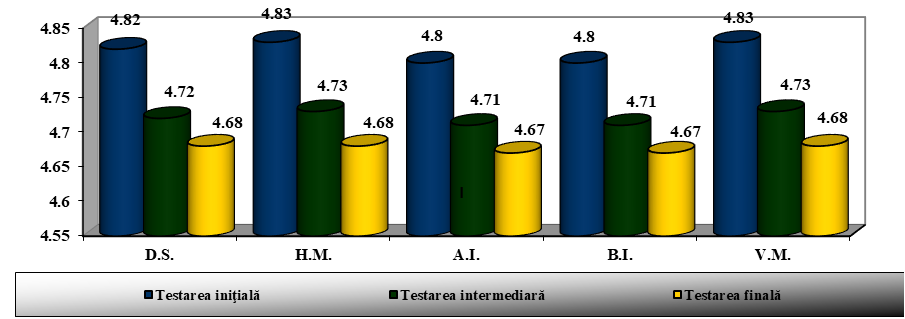
In Figure
This improvement of the results was consistent throughout the experiment (see Tables
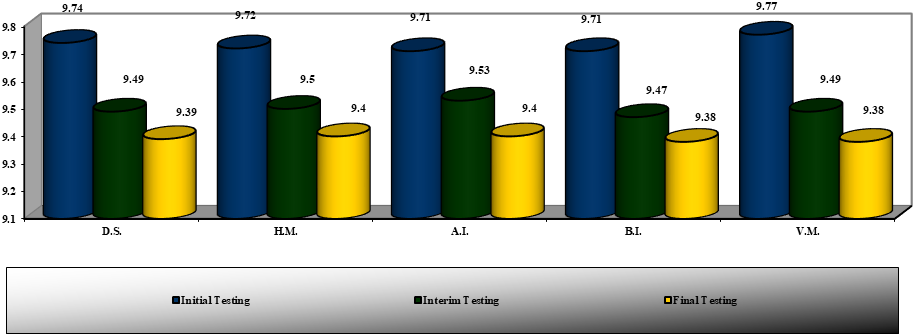
In Figure
This improvement of the results was consistent throughout the experiment (1,2,3,4,5), that means the programs used reached our objectives.
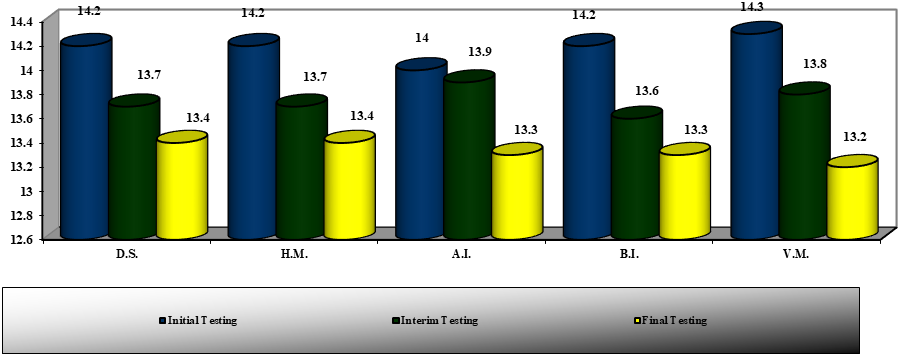
In Figure
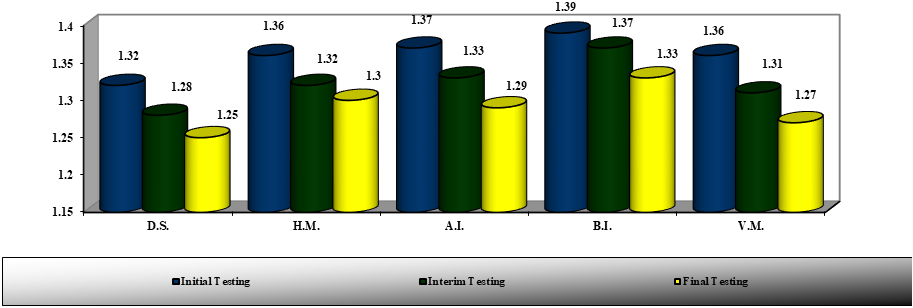
In Figure
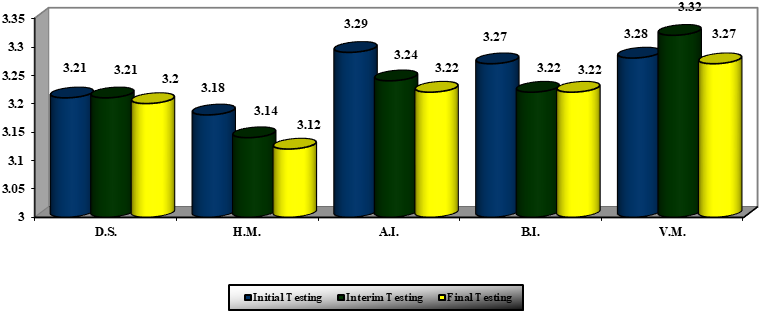
In Figure
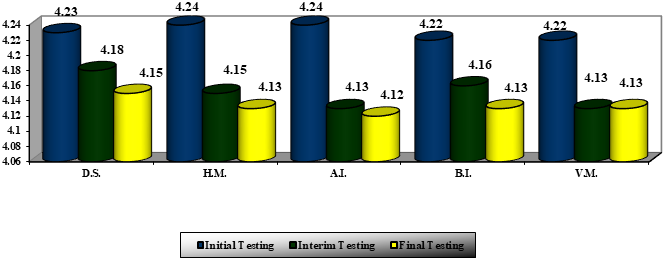
In the graphical presentation above you can notice that all experimental subjects are able to improve test results in 1000 m run (with 9’’ for D.S., with 11’’ for H.M., with 12’’ for A.I.-and this one got the most significant progress and with 9’’ B.I. and V.M), revealing that the average results of the experimental group obtained a good average of results from this sample with regard to the age of football players. For us these results are satisfactory, because the attackers mainly aim was to develop all forms of speed used in football training.
Conclusion
Physical training in football game is an important component of training, the way to do this depends on getting the sports performance. This assertion is based on the results obtained in the experiment control samples, revealing a strong dependence between test results and motility capacity results in football game. Physical training of football players specialized in the striker position during wintertime can and must be performed according to a training plan, its proportion being determined during the preparatory period, but being found in competition, transition and recovery periods in different forms of energetic substrata of motility actions.
Clear difference of physical fitness training is not our singular objective in the pre competition period, where the predominant is physical general training and where non-specific means are dominant, although even in this period the physical training must be made through specific means, compliance with the ball thing in football game. A perfect separation from other components of physical training workout is not good for performance football training because physical training must be always understood as the substratum of each motility act. A good physical training can compensate the lack of a special technical training, especially for defenders, in which a good physical training can lead to achieving a tight marking on a larger area and thus hinder the attack by the opposing team. We can see at the beginning of the championship a bad physical preparation because in the pre competition period, generally the training was realized superficially and not professional. Wintertime training should not be absent from the training plan of a football team, this part of training is elementary for the reorganization at the top level footballer of all bodily functions, allowing a gradual increase in the level of full functional performance of the athlete. Approach of physical training should be made both by regular and nonregular means, exercises with the ball became very important since the period before competitions.
Very important as recommendation, physical training should be done by co-working of a coach or coaches with a physical training specialization, at the A Division teams physical coach position was established as a necessity claimed by modern football development.
References
- Bompa, T. (2002) Teoria si metodologia – Periodizarea [Theory and methodology. Periodization]. Constanta: Publishing House Ex Ponto.
- Cernăianu, C. (2002). Fotbal. Manualul antrenorului de fotbal [Football. The professional coach’s manual] Bucharesti: Rotehpro Publishing House.
- Colibaba-Evuleţ, D. & Bota, I. (1998). Jocuri sportive, teorie si metodica. [Sport games; theory and methodology]. Bucuresti: Publishing House Aldin.
- Cojocaru, V. (2001). Fotbal – notiuni generale [Football – general notions]. Bucuresti: Axis Mundi Publishing House.
- Cojocaru, V. (2002). Fotbal de la 6 la 18 ani [Football from 6 to 18 years old]. Bucuresti: Axis Mundi Publishing House.
- Trapattoni, G. & Cecchini, E. (2005). Konzeption und Etwicklung der Taktik im Fussball. Edizioni: Nuova Prhontos.
- Gîrleanu, D. (1999). Pregatirea fizica a jucatorilor de fotbal [Physical training at football players]. , Bucureşti: Publishing House Răzeşu.
- Leali G. (2006). L’allenamento delle capacità fisiche nel calcio. Koala Libri - Reggio Emilia.
- Neţa, Gh. (2005). Fundamentele jocului de fotbal. [Fundaments of the football game]. Cluj-Napoca: Publishing House Risoprint.
- Neţa, Gh. (2008). Strategia performantei in fotbal [Performance strategy in football]. Cluj-Napoca: Dacia Publishing House.
- Niculescu, A. & Ionescu, I. (1975). Fotbal metode si mijloace , [Footbal methods and means]. Bucuresti: Didactical and Pedagogical Publishing House.
- Stancu M. (2015). Femeia si motivarea de a practica activitati de timp liber [Women and motivation to practice free time activities]. Piteşti: Publishing House.
Copyright information

This work is licensed under a Creative Commons Attribution-NonCommercial-NoDerivatives 4.0 International License.
About this article
Publication Date
15 August 2019
Article Doi
eBook ISBN
978-1-80296-066-2
Publisher
Future Academy
Volume
67
Print ISBN (optional)
-
Edition Number
1st Edition
Pages
1-2235
Subjects
Educational strategies,teacher education, educational policy, organization of education, management of education, teacher training
Cite this article as:
Cojanu*, F., & Visan, P. F. (2019). Methodologic Aspects Of Specific Physical Training To Junior’s B Football Players. In E. Soare, & C. Langa (Eds.), Education Facing Contemporary World Issues, vol 67. European Proceedings of Social and Behavioural Sciences (pp. 2100-2108). Future Academy. https://doi.org/10.15405/epsbs.2019.08.03.261
